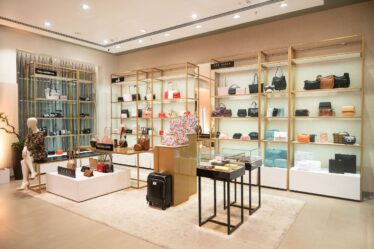
This article first appeared in The State of Fashion: Technology, an in-depth report co-published by BoF and McKinsey & Company.
Across the varied funding taking place in fashion tech, investors are emphasising technologies that make commerce more nimble, more sustainable and more engaging to shoppers, whether they’re buying their goods new or used, in stores or online. Many are also making non-fungible token (NFT) and metaverse-related moves, but they’re starting slowly in these areas and doing their research to determine what opportunities lie beyond NFTs as collectibles.
In 2021, the value of the top 50 investments in technology related to fashion grew 66 percent compared to 2019, reaching $16.2 billion, according to McKinsey analysis of data from Crunchbase, a business-information platform. The investments considered in this analysis went towards either fashion retailers or businesses selling products and services to fashion firms, rather than fashion brands. E-commerce, having benefitted from the pandemic-driven surge in online shopping, received roughly 55 percent of the investment. The remainder largely comprised payment technologies, including “buy now pay later” firms, social commerce and resale, followed by supply chain and logistics companies and those working in NFTs or technologies like virtual reality.
Investors say e-commerce has room for further growth and innovation. For instance, new marketplace models that are “inventory light” and help individual creators and sellers have been one area of focus for Forerunner Ventures, a San Francisco-based fund.
“On the back end — the commerce-enablement side, where we spend a lot of our time investing — there’s been a tonne of innovation on the enabling tools and technologies powering anybody to be a seller, whether you are an incumbent brand or a creator or somebody just getting going,” said Nicole Johnson, a partner at Forerunner. As an example, Johnson cited Canal, a distributed commerce platform that aims to let individuals and companies of any size sell products on the same channels where customers first encounter them, such as YouTube or Substack. Forerunner has been one of the lead backers of the Bay Area start-up, which went live in 2021.
Frederic Court, founder of London’s Felix Capital, highlighted marketplaces as an area of interest as well, such as those that have their own strong point of view and emphasise a curated shopping experience. “In a world where there is so much choice, curation itself is a very important theme,” he said.
Consumer-facing fashion tech has drawn most of the investment in recent years, and that’s still the case. Social commerce, for example, saw a jump in funding in 2021, driven largely by a $500-million raise by China’s Xiaohongshu.
At Swedish fast-fashion giant H&M, executives are looking to e-commerce innovations that allow it to blur the line between online and in-store experiences and offer customers the same level of personalisation across channels. Alan Ting, the company’s head of M&A, described one potential idea where customers could log their purchases in a “digitised wardrobe,” and then when visiting a store, the H&M app would guide them to products they might like based on past purchases. The company is also continuing its investments in analytics and AI to leverage its massive trove of customer data, he noted.
In 2021, the value of the top 50 investments in technology related to fashion grew 66 percent compared to 2019.
Supply chains and logistics continue to draw investor interest. In late 2020, Singapore-based Lyra Ventures participated in a funding round for Material Exchange, a centralised materials database company. Reina Nakamura, a general partner at Lyra, said the database can help individual creators as well as brands competing against the likes of fast fashion juggernaut Shein to be nimbler in production.
Because of its digitised supply chain, Shein has visibility into the availability of materials that can be whipped into orders, making it more agile than brands relying on the traditional model of attending trade shows, exchanging physical samples and producing fabrics to order, according to Nakamura.
“This has always become the bottleneck for any agile upstream supply chain to be built, and I think Shein has really changed the game here,” she said.
Similarly, in 2021, Forerunner co-led a funding round for Swyft, which connects shipping carriers with vendors to let them offer same-day delivery and compete against Amazon’s logistics machine, Johnson said.
Resale is offering investors both a sustainability play and a growing market of shoppers, particularly younger ones. In recent consumer surveys from BoF Insights, 65 percent of respondents aged 18 to 24 said they have purchased secondhand fashion before.
Web3 and the metaverse are inescapable topics, and whilecapital is pouring into metaverse-related companies, investment on the fashion and retail side is just getting started.
H&M has said it will double its investments in 2022, focusing on areas such as tech and supply chain, renewable energy and sustainable materials. H&M’s most significant investments in fashion tech, for instance, have focused on Sellpy, the secondhand site it acquired in 2019, Ting said. In 2021 it launched Sellpy in 20 additional countries, bringing its total number of markets to 24, and told Reuters it has invested more than €20 million ($24.4 million) in the business.
Beyond H&M, resale companies including Vestiaire Collective, Grailed and Tradesy held funding rounds in 2021. Etsy acquired the Gen-Z-focused secondhand marketplace Depop, and more brands now offer resale of their own goods.
Pierre Denis, former chief executive of Jimmy Choo and now a fashion-tech investor based in London, pointed to the resale economy as one of several key investment targets, alongside data analytics and social commerce. He joined a $2.7-million funding round for Reflaunt, a “resale-as-a-service” technology company that supplies the backend infrastructure allowing brands and retailers to plug into a network of secondhand marketplaces and launch their own resale businesses.
Meanwhile, Lyra’s Nakamura pointed to resale logistics companies, such as Lizee, a French start-up founded in 2019 focusing on logistics solutions for rental and resale brands — something she said traditional warehouse-management systems aren’t designed to do. Lizee raised €1.3 million ($1.55 million) in a seed round in 2021.
While many of these investments aim to solve current industry pain points, investors are also keeping an eye on the future. Web3 and the metaverse are inescapable topics, and while capital is pouring into metaverse-related companies, investment on the fashion and retail side is just getting started. Johnson, for instance, said Forerunner is “walking before we run and thinking about where the consumer utility is and the biggest opportunities for mass consumer adoption in those spaces.”
But money is beginning to flow. Denis and Nakamura separately have backed Threedium, whose technology lets brands and retailers create 3D and augmented reality assets for use in e-commerce and a range of gaming environments. Nakamura described the company as a “backbone of everything 3D.”
H&M launched its first virtual fashion collection at the start of 2022. The company is working to understand what competencies it needs to develop — or acquire — in the space, according to Ting. “For sure, we’re going to need to offer our products in a digital fashion,” he said.




